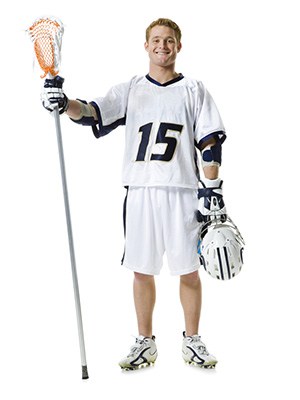Are you looking to dominate the lacrosse field? Do you want your stick to help unlock your fullest potential for speed, strength, and finesse?
If so, understanding the anatomy of a lacrosse stick is an essential part of becoming an ultimate player.
With our complete guide on the anatomy of a lacrosse stick, nothing will be able to stand between you and success out there on the field!
More...
Take Away Key Points:
3 main parts of a lacrosse stick
Lacrosse is a sport that requires special equipment, specifically a stick.
A basic lacrosse stick includes three main parts: the head, the shaft, and the pocket. Complete lacrosse sticks consist of both a strung head and a sturdy shaft.
1. The lacrosse head

The lacrosse head of a stick is the most important part. It's where you catch and cradle the ball, and it comes in different sizes and shapes depending on age and skill level. It needs to be strung tightly with mesh to form a pocket for controlling the ball. The lacrosse stick head attaches to most lacrosse shafts.
You can choose from several types of pockets, such as a deeper or shallow pocket, offset lacrosse heads, traditional pockets, and shooting strings, among others. They need to fit well over or under your arm so as not to interfere with catching or shooting accuracy.
a. Lacrosse head sidewalls
The sidewall of a lacrosse head is the raised area on the sides of the pocket, which helps keep the ball from overflowing from the head.
The sidewall also protects your hands from injury and helps keep the pocket stable for catching, passing, and shooting. It can be made from various materials such as plastic or nylon mesh and should be strung tightly with mesh for support.
b. Lacrosse head scoop
The scoop of a lacrosse head is the angled part that helps you cradle and controls the ball. It should be curved to fit the shape of a lacrosse ball and have enough flexibility to snap over the ball when catching it while also providing firm control when cradling and shooting.
c. Lacrosse head throat
The throat of a lacrosse head is the part of the head that connects the scoop to the sidewall and helps secure the pocket. It should be strung tightly with mesh so it does not come loose during play and to ensure ball control.
2. Lacrosse shaft
The shaft of a lacrosse stick, or just a stick, is the long, slender handle that connects the head to the grip. Some players will use the term "shaft" to refer to the entire lacrosse stick, not just the shaft part.
The right size and length of the shaft will depend on the player's height, style of play, and skill level. The shaft should be comfortable when held in both hands, have good grips for control, and have minimal vibration when contact is made with the ball. Although the lacrosse stick regulations have altered over the years, the shaft remained the same.
The shaft of a lacrosse stick is typically made from either aluminum, titanium shafts, or composite material. Aluminum shafts are lightweight, strong, and usually more affordable than composite shafts. On the other hand, titanium shafts are the strongest, and aluminum shafts tend to be more fragile.
However, they do not have the same level of flex as composite and can be more prone to denting. Composite shafts are usually lighter than aluminum and offer more feel for contact with the ball. They are more expensive than aluminum but also provide excellent durability and performance.
Regarding the level of play and league, women's lacrosse sticks are shorter than men's. Additionally, youth lacrosse sticks are very different from those used at college or high school.
3. Lacrosse pocket
The pocket of a lacrosse stick is an intricate webbing that allows you to cradle the ball in the head of the stick. Pockets come in low, mid, or high styles and are determined by their position on the head of the regular lacrosse stick.
The most common is the mid pocket, which is suitable for any playing position. High pockets allow more space between the ball stops at the base, providing better control over the ball. Lower pockets are positioned nearer to the head's throat, which allows the ball to rest near the stock and be held with just one hand - an advantage that offensive players like due to it enabling them to use their other arm while dodging opponents.
It can be made from various materials, including leather, nylon, and mesh. Each material has its advantages and disadvantages depending on the type of player and playing style.
- Leather pockets are traditionally favored by attackers as they offer a superior feel for cradling the ball.
- Nylon pockets provide good control but lack in feel for passing and catching.
- Mesh pockets are lightweight and provide good airflow to help reduce moisture buildup in hot conditions.
Lacrosse pocket strings
Lacrosse sidewall strings, or shooters, are a key piece of equipment in the lacrosse game. They are used to create a pocket, and the mesh sidewalls help hold the ball securely.
Additionally, these strings may be tied tightly for more control or loosely for bigger pocket sizes. Finally, thicker sidewalls are often used for defensive heads with defensive and midfield players.
How to choose the best lacrosse stick?

Choosing the right lacrosse stick is important for achieving success on the field.
Before making this decision, several factors and lacrosse stick parts should be considered, including pocket type, pocket depth, stick length and weight, head shape, and sidewall strings.
1. Pocket type
When considering the pocket type and depth, most players opt for a mid-depth pocket as it provides good control over the ball and is suitable for any position.
The type of pocket you have can greatly impact your game. Different pocket types provide different levels of control, allowing players to customize their lacrosse sticks to fit their playing style better.
High pockets offer more space between the ball stop at the base, providing better control over the ball. Lower pockets are positioned nearer to the head's throat, allowing for easy single-handed ball management.
2. Stick length
Stick length commonly ranges from 40 to 72 inches and should be chosen based on player height and playing style.
For example, a lightweight stick is preferred by most attackers, while defensive players may select a heavier option for increased strength during checking or ground play.
3. The shape of the head
The shape of the lacrosse stick's head also matters when choosing a stick - some options have straight heads creating uniform shooting channels with less drag on release, while curved heads create more unique shots and increased ball speed but require more skill to operate accurately.
Other players prefer lacrosse heads with a narrow face for better control when dodging and passing, while wider heads provide more stability for checking and ground balls.
The angle of the throat also affects how well you can cradle or scoop the ball in tight spots on the field. Understanding how these different aspects work together allows you to pick a head tailored to your skill level and playing style.
4. Sidewall strings
Finally, sidewall strings determine how deep a pocket one can create in their stick – choose quality materials such as leather or nylon for maximum grip, flexibility, and ground ball pickups.
Sidewall shooting strings play an important role in how a lacrosse basics stick handles and performs.
The lacrosse shooting strings make up part of the pocket and can have different materials, patterns, and tensions to adjust the stick's characteristics.
For example, higher-tension shooting strings act as a stabilizer that allows for more control when passing or shooting, while lower-tension shooting strings provide more give and flexibility.
Is a goalie stick different from a basic lacrosse stick?
Yes, a goalie stick has a few distinct differences from regular lacrosse sticks. For example, Lacrosse goalie sticks are typically longer – up to 72 inches – and have larger and wider heads than basic sticks.
The additional length gives goalies the reach needed to stop shots from going in, while the bigger and wider head makes it easier to trap and control the ball.
Additionally, goalie's heads are stiffer than regular heads, so they can better withstand the impact of powerful shots.
How to maintain a lacrosse stick?
Maintaining a lacrosse stick is important to keeping it in top condition and performing its best on the field.
Cleaning the head of the crosse regularly should be a top priority, as sweat and dirt can build up and impair your performance.
Be sure to use a soft cloth or brush to avoid damaging the strings, and check for any frayed or broken strings that may need replacing.
Finally, if you have metal shafts, apply some lubricant occasionally to prevent rusting and corrosion. Taking these steps will help keep your crosse well-maintained and ready for action!
How to repair a lacrosse stick?

Repairing a lacrosse stick is not as daunting a task as it might sound. Depending on the issue, you may be able to fix it yourself without having to replace the entire crosse.
The most common repair is replacing the pocket strings, which requires removing and retying them using a knot that won't slip or fray over time. You can find detailed instructions on how to do this online.
You may also need to replace your butt end if it has become cracked or loose or realign the head of the crosse with the shaft if they have become misaligned.
Again, there are online resources available that contain step-by-step instructions for making these repairs. With some patience and practice, you can successfully repair your lacrosse stick!
FAQs
What are the parts of a lacrosse stick called?
There are three lacrosse stick parts: the head, shaft, and butt end.
The head is the net at the end of the lacrosse shaft and is used to catch and throw the ball. Finally, the butt end parts or the end cap of a lacrosse stick attaches to one end of the shaft and protects against hits.
What is the end of a lacrosse stick called?
The end cap of a lacrosse stick is called the butt end.
The butt end/end cap attaches to one shaft end and protects against hits. It can also be used as an extra grip on the stick when making throws.
What is the head of a lacrosse stick made of?
The head of a lacrosse stick is usually made of plastic. It is designed to cushion and hold onto the ball while providing an easy pass or throw.
The head shape also affects how well the ball is held and how well it releases when passing or shooting.
What is a lacrosse stick called?
Lacrosse sticks are sometimes referred to as crosse, and traditionally, it's made up of two pieces: the shaft and the head.
What kind of lacrosse stick should I get?
When selecting a lacrosse stick, the type should depend on the player's age, ability, and position they play.
In most cases, beginner players should look for a lighter head to help them learn proper technique faster.
A mid-level player should look for a heavier head and a more specialized lacrosse stick with more pocket depth to help better control the ball.
Advanced players may want to consider stick length, which can affect shot speed and accuracy.
Can you play lacrosse without a stick?
No, it is not possible to play lacrosse without a stick. A lacrosse stick is essential for passing and catching the ball, shooting goals, and defending opponents. It also grips onto the ball when in possession, allowing players to control their movement while they have the ball.
Is stringing a lacrosse stick hard?
Stringing lacrosse sticks does require some skill, but it is not overly complicated. Instead, it requires patience, attention to detail, and knowledge of the proper technique for stringing. There are stringing kits available that include instructions on how to string a lacrosse stick properly.
Conclusion
At the end of the day, a lacrosse stick is an essential tool for any player, no matter their skill level. Understanding the anatomy of a lacrosse stick, the elements, and its components can help players choose the right stick for their game and maximize their potential on the field.
With practice and knowledge, it is possible to create a custom lacrosse stick that perfectly fits each player's needs.
